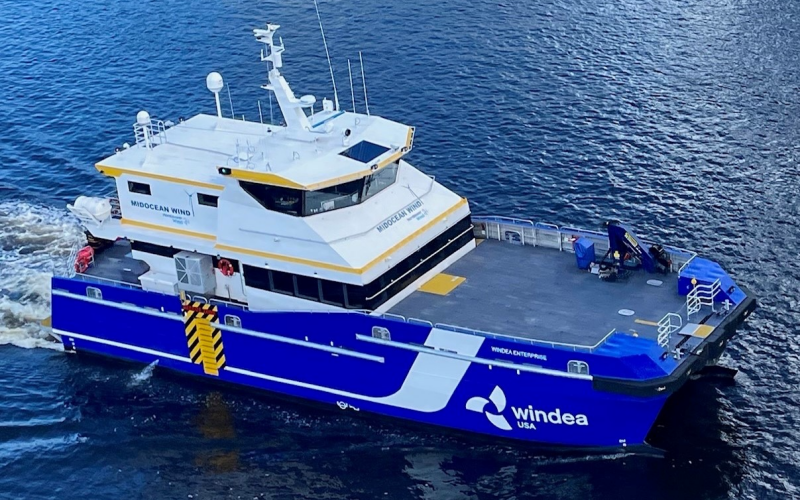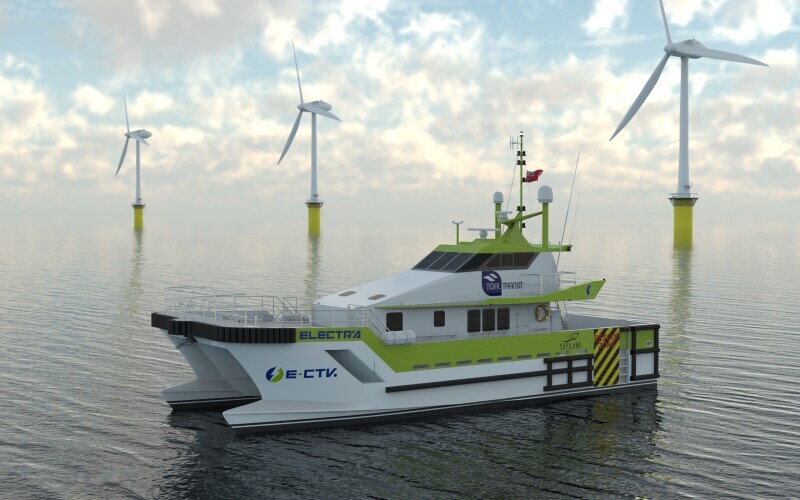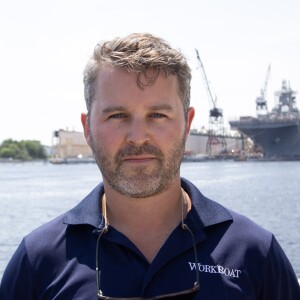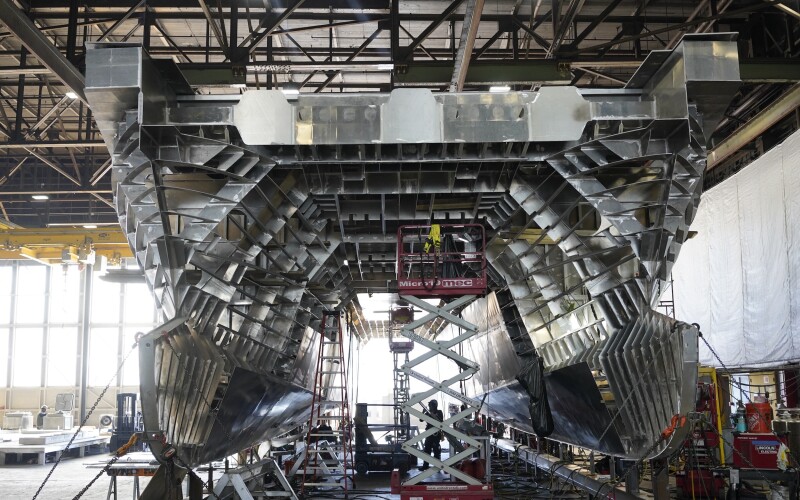As the offshore wind industry further cements its place in the future of energy production, support boats like crew transfer vessels (CTVs) have become a popular build over the past few years.
Different itertations of CTVs, variations in their configuration, alternative operations, and propulsion methods, are becoming part of the offshore wind fleet. Most CTVs are newbuilds, though conversions occur, like Coast Line Transfer’s charter fishing boat turned CTV for the Vineyard Wind 1 Project. The original boat, constructed by Geo Shipyard, New Iberia, La., in 2007, was modified in a four-month turnaround time that allowed the vessel to maintain its Jones Act compliance.
NEWBUILDS
During a recent WorkBoat shipyard tour, three New England yards within 30 miles of each other shared a notable commonality — all were constructing CTVs.
Senesco Marine, North Kingstown, R.I., is currently working on the final two of six WindServe Marine CTVs. The first four have all been delivered. Gladding-Hearn Shipbuilding, The Duclos Corp., Somerset, Mass., is building the 89'x30' Patriot Leader for Patriot Offshore Maritime Services, New Bedford, Mass.
Blount Boats, Warren, R.I., is working on its second of two 99'x36.7' CTVs that are owned and operated by American Offshore Services (AOS), Providence, R.I. The first CTV, Gripper, was delivered in March 2024.
Senesco has already delivered the Windserve Journey, Wind- serve Odyssey, Windserve Explorer and Windserve Genesis. All four CTVs measure 88.6'x29.5'x5.6' and can carry up to 24 technicians.
The aluminum catamarans were built with conventional Volvo Penta D13 main engines, each rated at 690 hp at 2,300 rpm, and a Volvo Penta IPS 900 integrated propulsion system. The vessels can achieve a service speed of 24 knots, with top speed capability of 27 knots.
WindServe Genesis is providing crew transfer support at Ørsted’s South Fork Wind project off the coast of Long Island, N.Y., before heading to work on the Revolution Wind project (R.I.), and Sunrise Wind project (New York).
For the final two CTVs currently under construction, the engine control rooms have been pushed out an additional six feet to accommodate hybrid-ready battery capabilities.
“We’re not supplying the hybrid system at this time, but in the event a customer in the future wants that, there’s enough room in the back of the engine room to go hybrid,” said Ted Williams, Senesco’s president.

Offshore vessel operator WINDEA CTV LLC is having three aluminum 98'5"x32'10"x14'5" CTVs built in the U.S. St. Johns Ship Building, Jackson- ville, Fla., delivered the first two vessels in February 2024 and June 2024, respec- tively. The third WINDEA CTV will be built by Gulf Craft, Franklin, La.
All three vessels will be propelled by four Volvo Penta IPS units driven by Volvo D13 main engines, producing 690 hp each. The vessels will be fully hybrid-ready, meaning the integration of the hybrid system is completely accommodated in the design, including dedicated voids for batteries, reserved cabling space, and battery removal hatches. The propulsion package will give the WINDEA boats a running speed of 26 knots.
Dave Brown, director of marine diesel sales at Volvo Penta, highlighted the distinct advantages that their integrated propulsion system offers, specifically in its thrust capabilities, which he said out- perform traditional propulsion methods.
“What IPS does when you really start talking about it within the offshore wind market, in the capabilities that it provides, above and beyond traditional propulsion, is that thrust. And the ability to put this boat up against a piling, in a type of sea state, and allow for operators to get on and off that wind farm platform in a safe manner,” Brown said.
He noted that a lot of the buzz around Volvo’s IPS is customer-driven, and he spoke to the fuel savings that comes with the propulsion system. “The developers of offshore wind, since they pay the fuel bill, are extremely interested in having IPS because there is a significant fuel savings when you’re running with IPS, typically, somewhere in the 30 percent range. And so those things in coordina- tion with the support that we’ve done on a global scale, we’re bringing that expertise here in the states,” he said.
BEEFED UP
With offshore wind more advanced in Europe than in the U.S., maritime professionals note that the American offshore wind industry is adopting the trends it sees abroad.
New CTV concepts are being designed in response to the demand for larger CTVs servicing bigger turbine installations farther from shore. An example of this is the 180'x52.5'x14.8' Midi-SOV (service operations vessel), adopted in June 2024 by UK-based operator North Star. The vessel is a product of naval architect Chartwell Marine Ltd., Southampton, U.K. and Vard, Alesund, Norway, designed to address the gap between current CTVs and larger SOVs.
Andy Page, director at Chartwell Marine, spoke to the need for this vessel design’s hybridization. “We don’t have the luxury that we have in Europe of having lots of vessel availability,” he said. “So, we’re going to have to use possibly fewer vessels to do more work. That’s really where the SOV is impor- tant. But perhaps the market can’t afford the full scale, and that’s where the Midi finds a perfect place in the market.”
The Midi-SOV is designed to be Jones Act compliant and ready for construction in U.S. shipyards.

Announced in April 2024, the world’s first retrofitted, electric CTV will be powered by a Volvo Penta electric propulsion system, replacing the diesel engines with a 100% emissions-free solution. Volvo Penta will supply its IPS system for the Ginny Louise, a 65', diesel-powered Mercurio vessel. The Mercurio Group is a parent of Astilleros Mercurio Plastics and Astilleros de Cartagena, Madrid, Spain.
The old propulsion system will be replaced with a quad installation of Volvo Penta IPS 30s, paired with fully electric motors.




